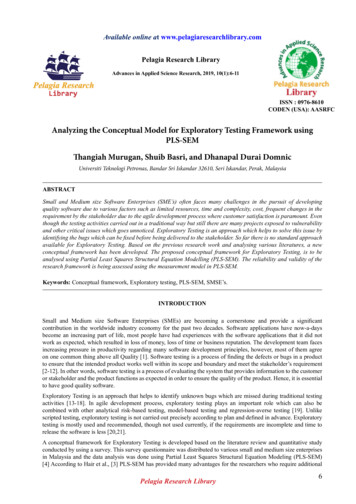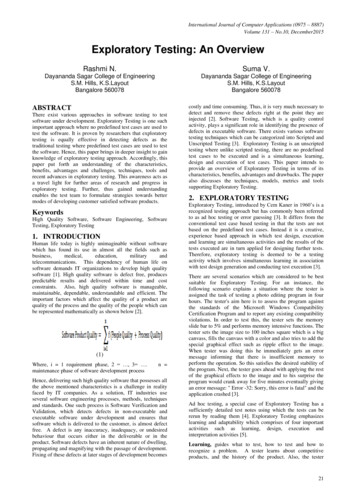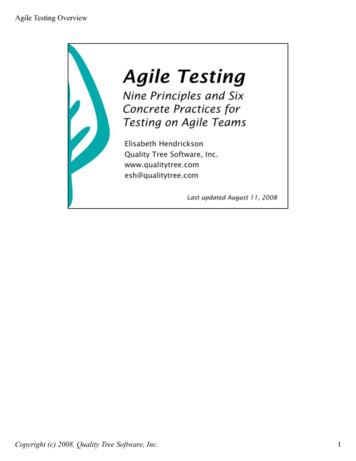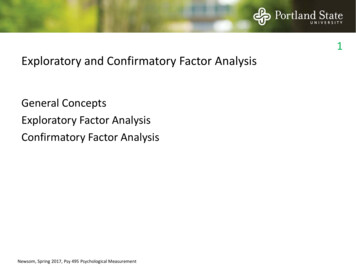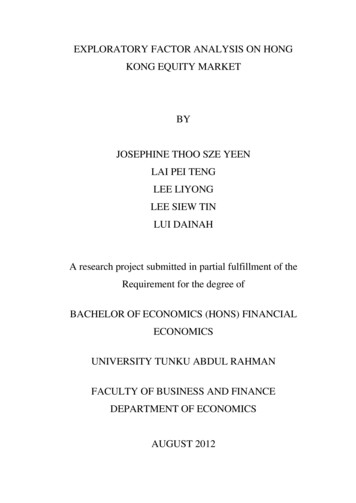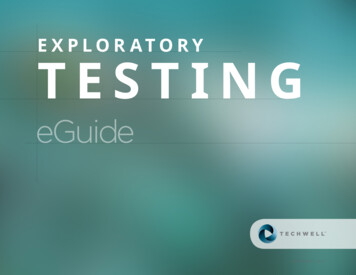
Transcription
E X PLO R AT O RYTESTINGeGuideCOPYRIGHT 2017
EXPLORATORY TESTING36 Skills Needed forExceptional ExploratoryTesting5Finding a Middle Groundbetween ExploratoryTesting and TotalAutomation6Continuous ExploratoryTesting: ExpandingCritical Testing acrossthe Delivery Cycle8Integrating ExploratoryTesting into ProductDesign9Using Tours to StructureYour Exploratory Testing14Insight from around theIndustry15eGuideAs attention, effort, and spending shift from manual to automated software testing, many in the software industry are questioning the role of thehuman software tester in this new landscape. While we often see increases in speed, efficiency, and cost savings from automated testing, therewill always be testing functions that can only be done effectively by a skilled exploratory tester. This eGuide explains why exploratory testing stillplays a critical role in the development process and how it fits in today’s agile and DevOps-focused world.In This Exploratory Testing eGuide6 Skills Needed for Exceptional Exploratory TestingIntegrating Exploratory Testing into Product DesignFinding a Middle Ground between ExploratoryTesting and Total AutomationUsing Tours to Structure Your Exploratory TestingContinuous Exploratory Testing: Expanding CriticalTesting across the Delivery CycleInsight from around the IndustryWhile anyone can claim to be an exploratory tester, only those witha set of honed skills will discover hard-to-find bugs that could impactyour mobile app or website. Exploratory testers must possess thesesix skills if they are to find the edge cases that could derail a successful software release.The automator wants to get rid of human exploration—they want arobot to cut down a forest and stack the wood. The explorer, on theother hand, sees tools more like a chainsaw—they allow humans togo ten times faster, but a human is still driving the process. Finding amiddle ground is the best test strategy.Continuous testing entails executing automated tests to obtain rapidfeedback on business risks. Where does that leave exploratory testing? Obviously, it doesn’t make sense to repeat the same exploratorytests across and beyond a sprint, but exploratory testing can be acontinuous part of each software delivery cycle.Exploratory testing, or ET, is a good fit for agile processes, can bedone by any member of the dev/test team, and helps develop applications that map to customers’ needs. Kevin Dunne writes how withincreased use of ET, testing becomes an intellectual pursuit drivingproduct quality and agility.In testing, a tour is an exploration of a product that is organizedaround a theme. Tours bring structure and direction to explorationsessions, so they can be used as a fundamental tool for exploratorytesting. They’re excellent for surfacing a collection of ideas that youcan then further explore in depth one at a time, and they help youbecome more familiar with a product—leading to better testing.Find out what experienced agile practitioners have to say about implementing agile.Additional Exploratory Testing ResourcesAdditional ExploratoryTesting ResourcesCOPYRIGHT 20182
EXPLORATORY TESTING36 Skills Needed forExceptional ExploratoryTesting5Finding a Middle Groundbetween ExploratoryTesting and TotalAutomation6Continuous ExploratoryTesting: ExpandingCritical Testing acrossthe Delivery Cycle8Integrating ExploratoryTesting into ProductDesign9Using Tours to StructureYour Exploratory Testing14Insight from around theIndustry15Additional ExploratoryTesting ResourceseGuide6 Skills Needed for ExceptionalExploratory TestingBy Nicholas RobertsWhile anyone can claim to be an exploratory tester, only those witha set of honed skills will discover hard-to-find bugs that could impactyour mobile app or website. It requires skills that go above andbeyond.Here are six skills needed to be an exceptional exploratory tester.1. Lateral thinkingLateral thinking is when you solve a problem by an indirect approach, and it usually involves seeing the issue in a new way that noone else has previously. Essentially, it’s examining a problem witha creative mindset. After all, it’s hard to find bugs without thinkingoutside the box.With lateral thinking skills, you see the various ways users will interact with your app or website, and you can find bugs that would haveotherwise been undiscovered.2. Critical thinkingCritical thinking is the ability to use reasoning in a rational manner.This lets you discover hidden relationships between variables, whichincreases the possibility of finding high-risk bugs that conventionalthinking would not reveal. Critical thinking gets rid of the biases associated with personal beliefs, leading you to see valid reasons withan objective perspective.Those who possess critical thinking skills make actionable suggestions because of their ability to weigh the consequences and risksassociated with the search for bugs.COPYRIGHT 20183
EXPLORATORY TESTING3eGuide6 Skills Needed forExceptional ExploratoryTesting5Finding a Middle Groundbetween ExploratoryTesting and TotalAutomation6Continuous ExploratoryTesting: ExpandingCritical Testing acrossthe Delivery Cycle8Integrating ExploratoryTesting into ProductDesign9Using Tours to StructureYour Exploratory Testing143. Investigation skillsInvestigation skills provide a methodology that exploratory testerscan use to discover and reproduce bugs. More importantly, beingcomfortable with using these investigative capabilities allows you tostray from the set methodology when necessary.With investigation skills, you can set up a plan of attack when searching for bugs and will be familiar with the signs that your chosenmethod needs adjustments.4. Storytelling skills15Exploratory testing requires the ability to tell a story—in this case,the story of the app or website you test. As you examine it, you willcreate accounts of various uses for the software and how people willutilize it. When you find a bug, this is the climax of the story, leadingto the resolution, or the developers making adjustments to eliminatethe problem.Additional ExploratoryTesting Resources5. Communication skillsInsight from around theIndustryThe ability to communicate with other members of the team isessential for any exploratory tester. This allows you to coordinatewith additional inspectors, determining who will work on a particularaspect of the testing, so you do not overlook any part.Once you find a bug, communication skills are once again essentialin order to succinctly and accurately describe the issue as well as thesteps leading up to it. Developers will need to ask you questions andreceive clear explanations in response.6. Technical skillsSome types of testing do not require vast technical skills, only afamiliarity with the basics. But exploratory testing may look at thefull stack, from the user interface to the layers of software underneath, so you must have the skills to understand the programs andgeneral coding.In order to deliver high-quality products, you need to ensure thatyour testing finds the bugs that impact their usage. Exploratorytesters must possess these six skills if they are to find the edge casesthat could derail a successful software release.COPYRIGHT 20184
EXPLORATORY TESTING36 Skills Needed forExceptional ExploratoryTesting5Finding a Middle Groundbetween ExploratoryTesting and TotalAutomation6Continuous ExploratoryTesting: ExpandingCritical Testing acrossthe Delivery Cycle8Integrating ExploratoryTesting into ProductDesign9Using Tours to StructureYour Exploratory Testing14Insight from around theIndustry15Additional ExploratoryTesting ResourceseGuideFinding a Middle Ground betweenExploratory Testing and TotalAutomationBy Matthew HeusserTesters seem to be having the same argument over and over again.The automator wants to get rid of human exploration—that is, theywant to press a button, get a green bar, and ship to production. Insome cases, they might want to commit to version control, havesomething else automatically press the button, and automaticallyship to production. This is akin to having robots cut down a forestand stack the wood: no humans involved.The explorer, on the other hand, wants a human intervention step.They see tools more like a chainsaw. The chainsaw allows the humanto go ten times as fast, but a human is still in charge, driving the process. The explorer doesn’t want robots to do everything automatically; they want to be a cyborg, a six-million-dollar man, to balance thehuman and the machine.When the explorer says of course tools are important, the automator gets angry because that is not what the automator means. Theresult could be a no-hire, a lost chance to collaborate, or even theend of a friendship.I believe the two have something to learn from each other.The implicit assumption of the automator is that the automated tests areall there is. Of course, that is not the case; most web applications automated with Selenium still need to test printing, tab order, font size, andplenty of other features that are hard (if not impossible) to automate.The tools influence the thinking, tempting testers to ignore risks thetool does not support. The best testers still make a list of these otherrisks and invest some time into exploration.Also, writing automation takes a long time. There are plenty of risksthat are expensive to put into code and unlikely to break if they worknow, so testers can get away with one-time tests. The automator’sworldview ignores these problems.Meanwhile, the explorer is dismissing the value of tools that run allthe time, unattended. At best, the explorer might have Seleniumrunning on Jenkins on every commit, or create virtual servers on demand—these are tools that significantly reduce risk and can be donefor better or worse. Many explorers dismiss these tools because theydon’t understand them, because they think they’re someone else’sjob, or because they’re maintained by the programmers.The explorer can benefit by expanding his idea of risk management,and the same goes for the automator.I suggest we start the conversation from what we agree on, explainto the other person where we differ, then figure out if there is a wayto blend the ideas, like peanut butter and chocolate. The ideal wouldbe to have the code deployed to production on every commit whilecontinuously exploring production and staging for emergent risks,using the logs, customer feedback, new features, version control,and developer interviews to help inform us of those risks.It’s a tall order, I know. Still, I think a collaboration is better thaneither of those ideas on their own.COPYRIGHT 20185
EXPLORATORY TESTING36 Skills Needed forExceptional ExploratoryTesting5Finding a Middle Groundbetween ExploratoryTesting and TotalAutomation6Continuous ExploratoryTesting: ExpandingCritical Testing acrossthe Delivery Cycle8Integrating ExploratoryTesting into ProductDesign9Using Tours to StructureYour Exploratory Testing14Continuous Exploratory Testing:Expanding Critical Testing acrossthe Delivery CycleBy Ingo PhilippContinuous testing is the process of executing automated teststo obtain rapid feedback on the business risks associated with asoftware release. Where does that leave exploratory testing? It’snot automated, but it’s certainly critical for determining whether arelease candidate has an acceptable level of risk.Test automation is perfect for repeatedly checking whether incremental application changes break your existing functionality. However, where test automation falls short is at helping you determineif new functionality truly meets expectations. Does it address thebusiness needs behind the user story? Does it do so in a way that’seasy to use, resource-efficient, reliable, and consistent with the restof your application?Exploratory testing promotes the creative, critical testing required toanswer these questions. Obviously, it doesn’t make sense to repeat thesame exploratory tests continuously across and beyond a sprint, butexploratory testing can be a continuous part of each delivery cycle.Insight from around theIndustryHere are a few ways teams embed exploratory testing throughouttheir process.15Perform Ad Hoc Exploratory Testing as Each UserStory is ImplementedAdditional ExploratoryTesting ResourceseGuideThis is the exploratory testing equivalent of peer code review. Whena developer completes a user story, they sit down with a tester. First,the tester starts testing while providing a running commentary onCOPYRIGHT 20186
EXPLORATORY TESTING36 Skills Needed forExceptional ExploratoryTestingeGuidewhat they are doing and why. Next, the developer takes control,explaining how they would test the software given their knowledgeof the implementation details and challenges. The developer gains auser- and business-focused perspective of the functionality, and thetester learns about the inherent technical risks.the end of the session. Often, this turns testing into a competition,where each participant tries to uncover the most or “best” issues inthe allotted time.Another tactic is to have the developer and a tester separately testthe same feature simultaneously, then discuss their findings at6It’s simply not possible to perform exploratory testing or full regression testing on every code commit. That’s what smoke testing is for.Instead, many teams run full regression testing and session-basedexploratory testing in parallel a few times per week, wheneverthey’ve implemented new functionality that an end-user could feasibly exercise.Continuous ExploratoryTesting: ExpandingCritical Testing acrossthe Delivery CycleFor optimal results, these sessions should be lightly planned, tightlytimeboxed, include diverse perspectives, and really take the sixthinking hats theory seriously.5Finding a Middle Groundbetween ExploratoryTesting and TotalAutomation8Integrating ExploratoryTesting into ProductDesign9Using Tours to StructureYour Exploratory Testing14Insight from around theIndustry15Additional ExploratoryTesting ResourcesAlign Exploratory Testing Sessions with FullRegression TestingHost Blitz Exploratory Sessions for CriticalFunctionalityThe best way to uncover user experience issues before end-usersis to get a broad array of feedback prior to release. One way is tohost “blitz” exploratory testing sessions. When you’re wrapping upwork on critical new functionality, invite people from a variety ofbackgrounds and teams to participate in a short timeboxed session.Incentives can help drive participation, maximize results, and maketesting fun.Using test automation to continuously check the integrity of existingfunctionality is certainly critical. However, if you’re not also makingexploratory testing a continuous part of your process, how will youknow if the new functionality meets expectations?The goal of continuous testing is to understand whether a releasecandidate has an acceptable level of risk. Exploratory testing is perfectly suited for helping you answer that critical question.COPYRIGHT 20187
EXPLORATORY TESTING36 Skills Needed forExceptional ExploratoryTesting5Finding a Middle Groundbetween ExploratoryTesting and TotalAutomation6Continuous ExploratoryTesting: ExpandingCritical Testing acrossthe Delivery Cycle8Integrating ExploratoryTesting into ProductDesign9Using Tours to StructureYour Exploratory Testing14Insight from around theIndustry15Additional ExploratoryTesting ResourceseGuideIntegrating Exploratory Testinginto Product Designby Kevin DunneExploratory testing, or ET, is becoming increasingly important ontoday’s testing teams, especially for companies embracing agile.Simply put, ET is a testing method that relies on investigative approaches and is implemented through parallel learning, test design,and test execution.By supplementing manual scripted and automated testing methodologies with ET, software teams can employ a free-form explorationof an application that should dramatically improve its overall quality,performance, security, and usability. ET is a valuable tool for findingcritical defects in software that wouldn’t have been discovered otherwise, uncovering potential improvements in code that are hiddenin an untested area, and double-checking that a critical customerfeature will work under all circumstances.developers and testers into a phase of exploratory testing in between sprints or at other ad hoc times. By breaking out areas of theapplication into assignments for individual exploration, you couldexpose a vital new area for product enhancement and usability. Another bonus: You are simultaneously driving better information andidea-sharing between team members and greater understanding ofthe product’s overall functionality.ET for UAT: Convincing product owners or subject matter experts totake a turn in exploratory testing, especially on critical features, is aneffective way to drive ownership around the QA process and results.Because product owners typically have a closer relationship to thecustomer and business, they may bring a new perspective to theusefulness of an application or its features.ET fits well with agile processes because it doesn’t depend on theheavy documentation of scripted testing, so it speeds time to market.And any member of the dev/test team can do exploratory testing,regardless of their specific skill sets. This gives product teams neededflexibility to pull resources into testing when schedules are tight.Beta testing: Beta testers from the community who aren’t typically skilled in development or testing supply the critical customerviewpoint of a product. Instead of a free-for-all approach, give betatesters a specific charter or mission based on whatever aspects ofthe application deserve attention.The goal, of course, is developing higher-quality applications thatmap more closely to customer needs. Below are a few ideas for integrating ET into your team and work processes.Replace traditional testing: Many organizations can replace someof the manual scripted tests being performed with automatedones—or, if manual tests are duplicative or ineffective, they can begotten rid of altogether. With this newly found bandwidth, you canput those testers to use in exploratory testing sessions. In testing,as in all areas of product design and development, efficiency is asimportant as speed.Pair with developers: A highly collaborative way to get started (andthat has been proven to improve software quality) is through pairedtesting and development. It’s the fastest way to validate new functionality, as there’s a much smaller lapse between code release andtesting to write an automated test or manual script.Team-based ET: Some software teams will engage a group ofAny tester or developer on your team already has the skills to helpwith ET efforts. By integrating exploratory testing, you can add valuequickly and easily to your overall product development goals.COPYRIGHT 20188
EXPLORATORY TESTING36 Skills Needed forExceptional ExploratoryTesting5Finding a Middle Groundbetween ExploratoryTesting and TotalAutomation6Continuous ExploratoryTesting: ExpandingCritical Testing acrossthe Delivery Cycle8Integrating ExploratoryTesting into ProductDesign9Using Tours to StructureYour Exploratory Testing14Insight from around theIndustry15Additional ExploratoryTesting ResourceseGuideUsing Tours to Structure YourExploratory TestingBy Nishi Grover GargI had just started working with a new product, a web-based platformthat was a fairly complex system with a large number of components, each with numerous features. Going into each componentand inside every feature would take too much time; I needed a quick,broad overview and some feedback points I could share as queriesor defects with my team.I realized my exploration of the application would need some structure around it. Using test sessions and predefined charters, I couldexplore set areas and come back with relevant observations—I haddiscovered tours.Cem Kaner describes tours as an exploration of a product that isorganized around a theme. Tours help bring structure and a definitedirection to exploration sessions, so they can be used as a fundamental tool for exploratory testing.Tours are excellent for surfacing a collection of ideas that you canthen further explore in depth one at a time. Tours testing providesa structure to the tester on the way they go about exploring thesystem, so they can have a particular focus on each part and notoverlook a component. The structure is combined with a theme ofthe tour, which provides a base for the kind of questions to ask andthe type of observations that need to be made.In the course of conducting a tour, testers can find bugs, raise questions, uncover interesting aspects and features of the software, andcreate models, all done on the basis of the theme of the tour beingperformed.Tours testing provides astructure to the tester onthe way they go aboutexploring the system, sothey can have a particularfocus on each part and notoverlook a component.Let’s discuss some common types of tours that are useful for testersand look at some examples.Application ToursAn application tour traverses the application screen by screen, withthe aim of exploration as well as learning the application.This is the first kind of tour I used, as an exploration method for mynew project, by investigating all the screens one by one, noting theoptions and features present, and getting familiar with the application.Let’s look at a sample banking mobile application with three screens.The first screen is the welcome screen with options, the second is theregistration screen, and the third is where we can fetch our accountstatement based on the time period range we select.COPYRIGHT 20189
EXPLORATORY TESTING36 Skills Needed forExceptional ExploratoryTestingeGuideHere are the details of our application tour, which gives us a general overview of the app.5Finding a Middle Groundbetween ExploratoryTesting and TotalAutomation6Continuous ExploratoryTesting: ExpandingCritical Testing acrossthe Delivery Cycle8Integrating ExploratoryTesting into ProductDesign9Using Tours to StructureYour Exploratory Testing14Insight from around theIndustry15Additional ExploratoryTesting ResourcesCOPYRIGHT 201810
EXPLORATORY TESTING36 Skills Needed forExceptional ExploratoryTesting5Finding a Middle Groundbetween ExploratoryTesting and TotalAutomationFeature ToursAfter becoming familiar with the application through the applicationtour and noting my interest areas and observations, I proceeded toperform a feature tour.For this I selected a concerned test area and tried out all the featuresof that area. I customized this tour a bit by focusing on the mostused and most valuable features, which I needed to learn for myupcoming user stories.eGuideIn a feature tour , the tester is encouraged to move through theapplication and get familiar with all features they come across. It canbe used for the purpose of learning as well as checking the functionality. Along with the most common features, the tester may also tryout the less popular features of the application, as time and exploration permit.For example, let’s conduct a mock feature tour of Microsoft PowerPoint. First we’ll start with adding a new slide. Our tour will focus onthe “Insert” features in the “Add Slide” contents.6Continuous ExploratoryTesting: ExpandingCritical Testing acrossthe Delivery Cycle8Integrating ExploratoryTesting into ProductDesign9Using Tours to StructureYour Exploratory Testing14Insight from around theIndustry15Additional ExploratoryTesting ResourcesCOPYRIGHT 201811
EXPLORATORY TESTING36 Skills Needed forExceptional ExploratoryTesting5eGuideOn the new slide, the default options that appear are “Add Header” and “Add Body.” Inside the “Add Body” option, the tour should include all thefeature options available, one by one—table, chart, picture, etc.—looking at the dialog boxes that pop up and touching on each available option.Finding a Middle Groundbetween ExploratoryTesting and TotalAutomation6Continuous ExploratoryTesting: ExpandingCritical Testing acrossthe Delivery Cycle8Integrating ExploratoryTesting into ProductDesign9Using Tours to StructureYour Exploratory Testing14Insight from around theIndustry15Additional ExploratoryTesting ResourcesCOPYRIGHT 201812
EXPLORATORY TESTING36 Skills Needed forExceptional ExploratoryTesting5Finding a Middle Groundbetween ExploratoryTesting and TotalAutomation6Continuous ExploratoryTesting: ExpandingCritical Testing acrossthe Delivery Cycle8Integrating ExploratoryTesting into ProductDesign9Using Tours to StructureYour Exploratory Testing14Insight from around theIndustryeGuideOf course we do not need to go into exhaustive detail for each feature. The only thing we are looking for is a structure and direction.This tour lets us pick where to focus more time and effort, whileother features we may choose to just touch upon.Menu ToursMenu tours navigate through all menus and submenus in the app,visiting each one for understanding and checking.I used a menu tour as a structured charter for a one-hour test session, traversing all menus, submenus, and items in the application.This brought me final clarity of what I needed to know about theapplication, the use of various options, and what lay within each one.I was free to go and explore the ones I needed in detail later.Here’s how to perform a menu tour: Go through all menus and submenus available in the application. Check for context-sensitive menus that become active or inactive under certain situations. Check for context-sensitive menus that come up with a right-click. Check for shortcut keys to activate menus and features. Look for option settings that reveal new features. Look for user-dependent features or menus.If required or if you find it useful, you may record all the options inthese menus and submenus as lists, diagrams, screenshots, or mindmaps. Let’s go back to the banking app example to demonstrate.A menu tour traverses all the menu and submenu items with theabove pointers in mind, and you could diagram it as above, right.15All these tours helped me speed up my learning and perform myexploration of applications in a directed manner. You can adoptthese tours as a part of your functional tests, exploratory cycles, orsystem tests.Additional ExploratoryTesting ResourcesOther Types of Tours Documentation tour: In this tour, you explore the user manualand help guide of the product and check the instructions forcorrectness of information provided, updates made for the newrelease features, user-friendliness, and the ease of understandability of the documentation. Interoperability tour: This tour aims to investigate the interaction of the system with third-party apps and systems, focusingonly on the interface points of the applications. Continuous use tour: Here, you tour the system for long, ongoing usage with multiple screens and files open for a prolongedduration in order to observe memory usage.I hope this introduction helps you start performing tours as part ofyour exploratory test sessions so that you can be more deliberatewith your observations, craft more useful tests, and better understand your products.Depending on your testing needs and context, there are even moretours you could perform:COPYRIGHT 201813
EXPLORATORY TESTING36 Skills Needed forExceptional ExploratoryTesting5Finding a Middle Groundbetween ExploratoryTesting and TotalAutomation6Continuous ExploratoryTesting: ExpandingCritical Testing acrossthe Delivery Cycle8Integrating ExploratoryTesting into ProductDesign9Using Tours to StructureYour Exploratory Testing14Insight from around theIndustry15Additional ExploratoryTesting ResourceseGuideInsight from Around the Industry“Exploratory testing is a time-based, minimum-planning, maximum-execution handson approach to testing. It focuses on findingknown-unknown and unknown-unknowndefects, which normally cannot be foundwith automated or any type of scriptedtests which cover known-known and unknown-known issues. Exploratory testing iswhere true testers really get to exercise theirskills, curiosity, and passion for testing, applymnemonic devices, and think outside of thebox to find most hard-to-find bugs.”» Tanya Kravtsov“Sometimes when we do exploratory testingwe find that the developer is trying to get thatburn-down chart to behave, and so they’repushing out code as fast as they can. Sure, theautomated test they wrote passed, but theydidn’t necessarily do their due diligence toreally examine the code and play with it.”» Matt Attaway“Testers have to take on new skills. No doubt.There still is manual testing, but it’s going tobe more exploratory testing, ad hoc testing.The role of the manual tester, having dedicated manual testers, is going away. It’s an automate-first culture, movement, if you will, andthat requires that testers be engineers andhave some level of programming expertise.”» Adam Auerbach“We really need exploratory testing forthese things. We need human judgmentand really what I see the role of automationdoing is freeing up the tester from the thingsthat would basically keep them tied to theassembly line. We don’t need testers to pressbuttons. We don’t need testers to executethe same recipe over and over. We wanthumans who actually can think and designand explore.”» Stephen Vance“Testing is something that is shifting frommore of a black box perspective into moredevelopers and we’re blurring that role.Then over the years, how that has kind ofcaused us to be confused about whether ornot automation is really automation and thattesting is merely an exploratory thing. Soeveryone seems to have a lot of confusionaround testing.”» Tariq KingWe want humanswho actually canthink and designand explore.“The way that I look at it is, you know, thecreative part of testing, which is the exploratory manual testing, is not going to go away.However, I would say that we would need aright mix of both—test automation and manual testing. If somebody tells me that they’redoing everything wi
Exploratory testing, or ET, is a good fit for agile processes, can be done by any member of the dev/test team, and helps develop appli- . plementing agile. Additional Exploratory Testing Resources In This Exploratory Testing eGuide. 3 6 Skills Needed for Exceptional Exploratory Testing 5 Finding a Middle Ground
